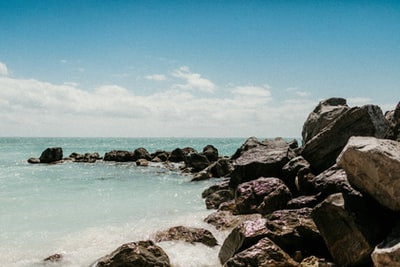It is hard to comprehend the geological time scale, which is vast compared to the human one.
When you hold a piece of rock in your hands, you are holding ancient history. It’s even possible that the rock you are holding is older than the earth itself. Our planet was formed 4.5 billion years ago and the universe is 13.7 billion years old. It is almost impossible to comprehend such huge tracts of time, so let’s think of a way to understand the age of our earth.
If we think of the tallest building in London, the Shard, which is over 1,000 feet tall, then the entire history of mankind – stretching back 8,000 years – would be a postage stamp laid flat on top of it.
There are many different types of rock, each of which formed at a different period in time. Granite first formed around 280 million years ago; carboniferous limestone first appeared 340 million years ago; chalk and clay between 200 and150 million years ago.
Our landscape is shaped in part by the type of rock beneath our feet. Granite is an igneous rock which can be seen on moorland areas as rocky outcrops. Chalk and clay are usually visible as cliffs and in dry valleys. Stalactites and stalagmites are composed of carboniferous limestone. Other underground features include caverns and dramatic structures like pillars, curtains. Limestone can be seen on the surface as limestone pavement, swallow holes, and dry valleys.
Every type of rock has its uses and is a resource exploited by man. Granite is often used in building and the production of cement; chalk and clay areas often have rich soil and are ideal for farming; areas where limestone is exposed are often areas of natural beauty and visited by tourists.
Granite has been used as a building material for thousands of years because it is so durable and has an attractive appearance ideal as a facade. Egypt’s pyramids were built using granite blocks.
Areas where permeable rocks such as chalk and clay content are high tend to retain water, and when this water is particularly plentiful the layer is called an aquifer. Groundwater can be extracted from the aquifer using wells and other forms of irrigation. Areas such as the South Downs in Southern England have a high chalk content and contain huge quantities of water.
Areas where the main rock content is carboniferous limestone are often areas of outstanding natural beauty. Two examples of these in the UK are the Yorkshire Dales and Peak District. Limestone itself has many uses, being an excellent building material (the Houses of Parliament are partly built from limestone) and is useful for cement and as a fertiliser.
Quarrying
Some rock is extracted by quarrying, and the location of a quarry must be considered in light of its economic, social and environmental impact. Discover how negative impact can be reduced by careful, sustainable management.
Demand for stone as a building material is higher than ever, but this can lead to problems for the local community. The most effective method of extracting stone is by quarrying, but many people object to this because the natural beauty of an area is often spoilt by the process. However some local people are in favour of quarrying as a source of revenue and employment.
In an ideal world there would be no need to extract rock by using quarrying methods, but in reality rock is always going to be needed for building and industry. The challenge for those wishing to exploit our natural resources is to ensure that the landscape isn’t damaged irreparably in the process.
Types of Weathering
Rocks are susceptible to weathering. The type of weathering that is most effective is determined by the composition of the rock and the climate. Learn about the three types of weathering: mechanical, chemical and biological.
Even the hardest rocks are susceptible to one of three types of weathering:
Mechanical weathering occurs when rocks are exposed to the elements, for example, to extreme cold, extreme heat and high pressure. No physical transformation takes place. Igneous rocks are particularly susceptible to mechanical weathering.
Chemical weathering occurs when rocks are broken down into smaller pieces by chemical reactions. This often takes place when the rock exposed to water. A type of rock that is often broken down in this way is sandstone.
Biological weathering occurs when rock is in contact with living organisms. An example of biological weathering is when moss grows on a drystone wall.


